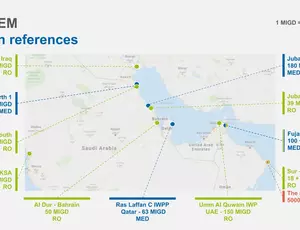Our History
A success built on Research & Development
Over the past 50 years SIDEM has developed several desalination solutions matching all types of requirements.
Thanks to strong and permanent in-house research & development SIDEM has been able to take the lead and maintain a technological advantage in the field of desalination plants based on multiple effect technology. This process is less capital intensive, easier to operate, cheaper in maintenance and more energy efficient than other conventional thermal desalination technologies.
SIDEM executes large desalination projects on a turnkey basis and is the sole provider of hybrid desalination solutions involving both thermal distillation and reverse osmosis.
The Early Days... ...from the beginning of the 20th century to 1970
EARLY EVAPORATORS : 1828-1934

FIRST LARGE PROJECTS BY CEM/SCAM

From 1970 to the late 1980s SIDEM becomes leader in the supply of MSF based desalination units
After its incorporation as a standalone entity, SIDEM grew rapidly and delivered ever bigger desalination projects.
Thanks to its collaboration with all concerned parties, clients and consulting engineers, SIDEM contributed in bringing MSF desalination plants to the level of reliability and efficiency that can be achieved nowadays.
Several MSF landmark projects were executed in that period: Ras Abu Aboud in Qatar (4 units of 11,400 m3/d in 1970 and 1975), Umm Al Nar in Abu Dhabi (7 units of 27,500 m3/d in 1976 and 1980), Al Khobar II in Saudi Arabia (10 units of 26,700 m3/d in 1979), Al Taweelah in Abu Dhabi (4 units of 35,000 m3/d in 1982 and 1991).
In parallel, SIDEM developed and further improved the MED process. Taking lessons from the old ME evaporators (submerged tubes, top brine temperature of around 70°C), SIDEM introduced the modern MED concept with spray-tube bundles and low operating temperatures, allowing this renewed process to get a level of reliability equivalent to MSF but with additional advantages, in particular: lower costs, lower electrical consumption, a better flexibility and also the possibility of reaching very high efficiency (GOR up to 17).
SOME MSF REFERENCES

From the 1980s to 2010 SIDEM becomes the world leader in MED technology
The first large SIDEM MED desalination unit (9,000 m3/d) was commissioned in 1992 in Sicily. The benefits of MED vs. MSF were confirmed and Sidem decided to promote that technology from there on.
The size of individual MED units continued to grow: Curaçao Island 12,000 m3/d (1994), Umm Al Nar UAE 16,000 m3/d (1998), Layyah UAE 22,700 m3/d (1999), Layyah 36,370 m3/d (2005), Fujairah II 38,670 m3/d (2007).
In 1998 SIDEM became part of the Veolia Environnement group, providing the company with additional financial backing and support to handle large desalination projects.
In 2007, SIDEM signed its largest contract for the engineering procurement installation and commissioning of 27 units of 30,000 m3/d for Marafiq, Saudi Arabia. With an overall installed capacity in excess of 800,000 m3/d, this was SIDEM's largest project ever and the world's largest desalination plant based on MED technology.
As a part of and with the support of other entities of the Veolia Group SIDEM was now able to provide the industry with strong, complete and integrated water solutions. As an illustration SIDEM together with sister company OTV have supplied the first hybrid plant of its kind at Fujairah, UAE. It consists of 12 MED desalination units of 38,000 m3/d each and a Reverse Osmosis plant of 140,000 m3/d. Commissioned in 2010 the desalination plant is able to produce 600,000 m3/d (equivalent to 130 million imperial gallons per day).
SOME MED REFERENCES

From 2010 to date SIDEM integrates the Reverse Osmosis technology in its scope of activities
In 2013, SIDEM merged with OTV-Major Projects Group, its sister company specialized in the large EPC projects in water treatment industry (Sea Water Reverse Osmosis (SWRO) and wastewater particularly) and which had completed 5 large SWRO plants:
- Sur Oman (phase 1 : 18 MIGD)
- Fujairah II (SWRO plant: 30 MIGD)
- Gold Coast (27 MIGD)
- Sydney (55 MIGD)
- and Az-Zour South (30 MIGD).
This alliance positioned SIDEM as the world leader in terms of desalination installed capacity for both thermal and reverse osmosis (RO) technologies.
Since then, SIDEM has completed Sadara SWRO (39 MIGD), Sur Extension (11 MIGD) and is currently completing Basra BWRO project (44 MIGD).
SOME RO REFERENCES

OUR MOST RECENT MED REFERENCES




